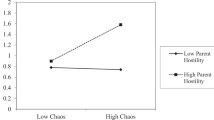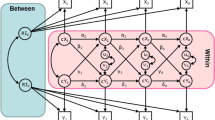Abstract
In recent years, research has examined the role of heightened emotional reactivity and poor regulation on maladjustment during childhood and adolescence. Although much of this research has shown a direct link between high emotional reactivity and maladjustment, there is less research on the ways in which reactivity interacts with contextual factors. Using data from the National Institute of Child Health & Human Development Study of Early Child Care and Youth Development (SECCYD), the current study asks how emotional reactivity in childhood, household chaos, and household income impact changes in emotional and behavioral problems between childhood and adolescence. Participants in the SECCYD were followed from birth until adolescence. Of these, 958 youth (52 % male; 80 % Caucasian, 13 % African American, 2 % Asian, and 5 % Other) who completed measures at age 15 were included in the current study. Results indicate that emotional reactivity and low household income during childhood directly predict higher levels of emotional and behavioral problems in adolescence. In contrast, the impact of household chaos on adolescent mental health depends on the child’s emotional reactivity. Specifically, the adverse impact of household chaos on emotional problems was observed among adolescents who were highly emotionally reactive as children, but not among their less reactive counterparts. Taken together, the relationship between an individual’s childhood context and temperament are important aspects in the prediction of outcomes in adolescents.


Similar content being viewed by others
References
Achenbach, T. M. (2001). Manual for the youth self-report and 1991 profile. Burlington, VT: University of Vermont Department of Psychiatry.
Achenbach, T. M., & Rescorla, L. A. (2001). Manual for the ASEBA school-age forms & profiles. Burlington, VT: University of Vermont, Research Center for Children, Youth, & Families.
Aiken, L. S., & West, S. G. (1991). Multiple regression: Testing and interpreting interactions. Thousand Oaks, CA: Sage Publications, Inc.
Belsky, J. (1997). Variation in susceptibility to rearing influences: An evolutionary argument. Psychological Inquiry, 8, 182–186.
Belsky, J., & Pleuss, M. (2012). Differential susceptibility to long-term effects of quality of child care on externalizing behavior in adolescence? International Journal of Behavioral Development, 36, 2–10.
Brooks-Gunn, J., & Duncan, G. J. (1997). The effects of poverty on children. The Future of Children, 2, 55–71.
Carthy, T., Horesh, N., Apter, A., & Gross, J. J. (2010). Patterns of emotion reactivity and regulation in children with anxiety disorders. Journal of Psychopathology and Behavioral Assessment, 32, 23–36.
Casey, B. J., Jones, R. M., Levita, L., Libby, V., Pattwell, S. S., Ruberry, E. J., et al. (2010). The storm and stress of adolescence: Insights from human imaging and mouse genetics. Developmental Psychobiology, 52, 225–235.
Charbonneau, A. M., Mezulis, A. H., & Hyde, J. S. (2009). Stress and emotional reactivity as explanations for gender differences in adolescents’ depressive symptoms. Journal of Youth and Adolescence, 38, 1050–1058.
Cichetti, D., & Cohen, D. J. (2006). Developmental psychopathology (2nd ed.). Hoboken, NJ: Wiley.
Duncan, G. J., Brooks-Gunn, J., & Klebanov, P. K. (1994). Economic deprivation and early childhood development. Child Development, 65, 296–318.
Duncan, G. J., Yeung, W. J., Brooks-Gunn, J., & Smith, J. R. (1998). How much does childhood poverty affect the life changes of children? American Sociological Review, 63, 406–422.
Eisenberg, N., Fabes, R. A., Nyman, M., Bernzweig, J., & Pinuelas, A. (1994). The relations of emotionality and regulation to children’s anger-related reactions. Child Development, 65, 109–128.
Eisenberg, N., Spinrad, T. L., & Eggum, N. D. (2010). Emotion-related self-regulation and its relation to children’s maladjustment. Annual Review of Clinical Psychology, 6, 495–525.
Ellis, B. J., Boyce, W. T., Belsky, J., Bakermans-Kranenburg, M. J., & Ijzendoorn, M. H. V. (2011). Differential susceptibility to the environment: An evolutionary-neurodevelopmental theory. Development and Psychopathology, 23, 7–28.
Evans, G. W. (2003). A multimethodological analysis of cumulative risk and allostatic load among rural children. Developmental Psychology, 39, 924–933.
Evans, G. W., Gonnella, C., Mareynyszyn, L. A., Gentile, L., & Salpekar, N. (2005). The role of chaos in poverty and children’s socioemotional adjustment. Psychological Science, 7, 560–567.
Evans, G. W., & Kim, P. (2007). Childhood poverty and health: Cumulative risk exposure and stress dysregulation. Psychological Science, 18, 953–957.
Evans, G. W., Kim, P., Ting, A. H., Tesher, H. B., & Shannis, D. (2007). Cumulative risk, maternal responsiveness, and allostatic load among young adolescents. Developmental Psychology, 43, 341–351.
Ge, X., Lorenz, F. O., Conger, R. D., Elder, G. H., & Simons, R. L. (1994). Trajectories of stressful life events and depressive symptoms during adolescence. Developmental Psychology, 30, 467–483.
Gustafsson, P. E., Anckarsater, H., Lichtenstein, P., Nelson, N., & Gustafsson, P. A. (2010). Does quantity have a quality all its own? Cumulative adversity and up- and down-regulation of circadian salivary cortisol levels in healthy children. Psychoneuroendocrinology, 35, 1410–1415.
Hasking, P. A., Coric, S. J., Swannell, S., Martin, G., Thompson, H. K., & Frost, A. D. J. (2010). Brief report: Emotion regulation and coping as moderators in the relationship between personality and self-injury. Journal of Adolescence, 33, 767–773.
Hayes, A. F. (2012). PROCESS: A versatile computational tool for observed variable mediation, moderation, and conditional process modeling [White paper]. Retrieved from http://www.afhayes.com/public/process2012.pdf.
Herts, K. L., McLaughlin, K. A., & Hatzenbuehler, M. L. (2012). Emotion dysregulation as a mechanism linking stress exposure to adolescent aggressive behavior. Journal of Abnormal Child Psychology, 40, 1111–1122.
Hessler, D. M., & Katz, L. F. (2010). Brief report: Associations between emotional competence and adolescent risky behavior. Journal of Adolescence, 33, 241–246.
Kliewer, W. (1991). Coping in middle childhood: Relations to competence, type A behavior, monitoring, blunting, and locus of control. Developmental Psychology, 27, 689–697.
Kovacs, M., Joormann, J., & Gotlib, I. H. (2008). Emotion (dys)regulation and links to depressive disorders. Child Development Perspectives, 2, 149–155.
Larson, R., & Ham, M. (1993). Stress and “storm and stress” in early adolescence: The relationship of negative events with dysphoric affect. Developmental Psychology, 29, 130–140.
Matheny, A. P., Wachs, T. D., & Ludwig, J. L. (1995). Bringing order out of chaos: Psychometric characteristics of the confusion, hubbub, and order scale. Journal of Applied Developmental Psychology, 16, 429–444.
McLaughlin, K. A., & Hatzenbuehler, M. L. (2009). Mechanisms linking stressful life events and mental health problems in a prospective, community-based sample of adolescents. Journal of Adolescent Health, 44, 153–160.
McLaughlin, K. A., Kubzansky, L. D., Dunn, E. C., Waldinger, R., Vaillant, G., & Koenen, K. C. (2010). Childhood social environment, emotional reactivity to stress, and mood and anxiety disorders across the life course. Depression and Anxiety, 27, 1087–1094.
Morris, A. S., Steinberg, L., Myers, S. S., & Robinson, L. R. (2007). The role of the family context in the development of emotion regulation. Social Development, 16, 361–388.
National Institute of Child Health and Human Development (NICHD) Early Child Care Research Network (ECCRN). (2001). Nonmaternal care and family factors in early development: An overview of the NICHD study of early child care. Applied Developmental Psychology, 22, 457–492.
Nock, M. K., Wedig, M. M., Holmberg, E. B., & Hooley, J. M. (2008). The emotion reactivity scale: Development, evaluation, and relation to self-injurious thoughts and behaviors. Behavior Therapy, 39, 107–116.
Obradovic, J., Bush, N. R., Stamperdahl, J., Adler, N. E., & Boyce, W. T. (2010). Biological sensitivity to context: The interactive effects of stress reactivity and family adversity on socioemotional behavior and school readiness. Child Development, 81, 270–289.
Preacher, K. J., & Hayes, A. F. (2004). SPSS and SAS procedures for estimating indirect effects in simple mediation models. Behavior Research Methods, 36, 717–731.
Preacher, K. J., Rucker, D. D., & Hayes, A. F. (2007). Assessing moderated mediation hypotheses: Theory, methods, and prescriptions. Multivariate Behavioral Research, 42, 185–227.
Rothbart, M. K., & Bates, J. E. (2006). Temperament. In W. Damon (Series Ed.) &, N. Eisenberg (Vol. Ed), Handbook of child psychology: Vol. 3. Social, emotional, and personality development (6th ed.) pp. 105–176. New York: Wiley.
Silk, J. S., Steinberg, L., & Morris, A. S. (2003). Adolescents’ emotion regulation in daily life: Links to depressive symptoms and problem behavior. Child Development, 74, 1869–1880.
Spear, L. P. (2009). Heightened stress responsivity and emotional reactivity during pubertal maturation: Implications for psychopathology. Development and Psychopathology, 21, 87–97.
Stocker, C., Dunn, J., & Plomin, R. (1989). Sibling relationships: Links with child temperament, maternal behavior, and family structure. Child Development, 60, 715–727.
Thompson, R. A., Lewis, M. D., & Calkins, S. D. (2008). Reassessing emotion regulation. Child Development Perspectives, 2, 124–131.
Walton, A., & Flouri, E. (2009). Contextual risk, maternal parenting, and adolescent externalizing behavior problems: The role of emotion regulation. Child: Care Health, and Development, 36, 275–284.
Zemon, J., Cassano, M., Perry-Parrish, C., & Stegall, S. (2006). Emotion regulation in children and adolescents. Developmental and Behavioral Pediatrics, 27, 155–168.
Acknowledgments
The NICHD study was directed by a Steering Committee and supported through a cooperative agreement (5 U10 HD027040). The content of this article is solely the responsibility of the named authors and does not necessarily represent the official views of the Eunice Kennedy Shriver National Institute of Child Health and Human Development, the National Institutes of Health, or individual members of the Network. Members of the Steering Committee of the NICHD Early Child Care Research Network, listed in alphabetical order, were: Jay Belsky (Birkbeck University of London), Cathryn Booth-LaForce (University of Washington), Robert H. Bradley (Arizona State University), Celia A. Brownell (University of Pittsburgh), Margaret Burchinal (University of California, Irvine), Susan B. Campbell (University of Pittsburgh), Elizabeth Cauffman (University of California, Irvine), Alison Clarke-Stewart (University of California, Irvine), Martha Cox (University of North Carolina, Chapel Hill), Robert Crosnoe (University of Texas, Austin), Sarah L. Friedman (Institute for Public Research, CNA), James A. Griffin (NICHD), Bonnie Halpern-Felsher (University of California, San Francisco), Willard Hartup (University of Minnesota), Kathryn Hirsh-Pasek (Temple University), Daniel Keating (University of Michigan, Ann Arbor), Bonnie Knoke (RTI International), Tama Leventhal (Tufts University), Kathleen McCartney (Harvard University), Vonnie C. McLoyd (University of North Carolina, Chapel Hill), Fred Morrison (University of Michigan, Ann Arbor), Philip Nader (University of California, San Diego), Marion O’Brien (University of North Carolina, Greensboro), Margaret Tresch Owen (University of Texas, Dallas), Ross Parke (University of California, Riverside), Robert Pianta (University of Virginia), Kim M. Pierce (University of California, Irvine), A. Vijaya Rao (RTI International), Glenn I. Roisman (University of Illinois at Urbana-Champaign), Susan Spieker (University of Washington), Laurence Steinberg (Temple University), Elizabeth Susman (Pennsylvania State University), Deborah Lowe Vandell (University of California, Irvine), and Marsha Weinraub (Temple University).
Author Contributions
B.G.S. conceived of the study, participated in its design and coordination, performed statistical analysis and drafted the manuscript. L.S. participated in the design and interpretation of the data, coordination of the study and measurement, and overall guidance and revision of the manuscript. All authors read and approved the final manuscript.
Author information
Authors and Affiliations
Corresponding author
Rights and permissions
About this article
Cite this article
Shapero, B.G., Steinberg, L. Emotional Reactivity and Exposure to Household Stress in Childhood Predict Psychological Problems in Adolescence. J Youth Adolescence 42, 1573–1582 (2013). https://doi.org/10.1007/s10964-013-9954-0
Received:
Accepted:
Published:
Issue Date:
DOI: https://doi.org/10.1007/s10964-013-9954-0




